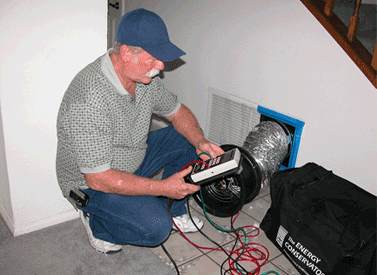
© Home Energy Rating Service 2005 - 2020 - State Licensed Title 24 HERS Rater Duct Test CalCERTS CC2005748
Main website https://HomeEnergyRatingService.com
Ventura County
Los Angeles &
Orange County
Home Energy Rating Service
Call 805 582-0750

Duct Test & Refrigerant Charge Measurement Requirements
Changes for New homes
WHAT IS CHANGING FROM 2016 TO 2019 Standards
Quite a few things. Here are the highlights for residential projects
HERS Testing Related
Quality Insulation Installation and associated HERS testing is prescriptively
required.
Whole house fan testing.
Kitchen exhaust hood verification.
Home Ventilating Institute (HVI) Product Directory
https://HVI.org/proddirectory/index.cfm
Home infiltration (blower door) if project utilizes continuous exhaust for attached
dwellings.
HVAC systems require MERV 13 filter.
Water heater credit for Drain Water Heat Recovery system.
Residential Solar
The new code requires solar photovoltaic systems for new homes.
For new residential homeowners, based on a 30-year mortgage, the Energy Commission estimates that the new code will add about $40 to an average monthly payment, but save consumers $80 on monthly heating, cooling and lighting bills. Nonresidential buildings will use about 30 percent less energy due mainly to lighting upgrades.
How the Refrigerant Charge Measurement verification works:
When a new A/C system is installed, the installing contractor performs the refrigerant charge measurement and has an independent, third party HERS rater verify. This applies when either replacing an existing HVAC unit or installing a new system. The contractor then fills out the appropriate sections of the standard CF-2R form indicating the proper amount of refrigerant charge. The HERS rater then verifies the refrigerant charge using one of two possible methods. The first method involves the HERS rater attaching their own gauges to the system to measure the refrigerant charge. Another approach may be used. This method requires the HVAC installer to install temperature measurement access holes and saturation temperature measurement sensors. This allows the HERS rater to verify the system performance and refrigerant charge without attaching gauges to the system.
The temperature measurement access holes are 5/16 holes that the contractor drills, one in the supply plenum. Exact locations are specified in the standards. HVAC installers can attend training seminars sponsored by the state to become familiar with the details of this process. You can became fairly proficient with the process in about 2 hours of hands on training.
The Saturation temperature measurement sensors are Type K thermocouples that are permanently attached to the evaporator coil and the condenser coil. The plug on the end of the thermocouple is plugged into a handheld digital thermometer to read the temperature which is then converted into pressure. The Type K thermocouple must be precisely attached to the indoor coil and the outdoor unit.
The HERS rater then will use their handheld digital thermometer to take eight temperature readings at the system. The temperature readings are then used to complete a worksheet that determines that a proper refrigerant charge for the system was used.
Cooling Coil Airflow test
Additionally, in Climate Zones 10-15, when both the air handler and the duct system are replaced, the HVAC installer must document that the air handler can deliver at least 350 cfm per ton in cooling mode. This applies to both split and package HVAC units. The airflow is measured at the return air grill using one of three approved methods:
1. Flow capture hood
2. Flow Grid Device
3. Plenum pressure matching procedure.
4. Temperature split. (Not allowed after 7/1/2014)
A well design duct system will meet the 350 cfm/ton requirement easily, however a duct system that is poorly designed, with many bends that inhibit airflow will fail this test. This test must be performed by an independent HERS rater. However the HVAC contractor must first measure the airflow themselves and then fill out the appropriate sections on the CF-2R form. The HERS rater verifies this with their own airflow test and then will fill out and register the CF-4R form which is then provided to the HVAC contractor, building department and homeowner.
Fan Watt Draw verification
In climate zones 10-15 if the HVAC contractor installs or replaces both the duct system and the air handler the system must meet a Fan Watt Draw standard of 0.58 watts per cfm of airflow for the air handler. This is a fairly simple test to perform. The first step is to measure the total system airflow. Then multiply this number by 0.58 which will give you the maximum watts that the air handler fan can draw. The final step is to measure the actual fan watt draw using either a plug-in watt meter or a clamp type amp meter and then convert the amps to watts. An independant HERS rater must verify this test and again fill out a CF-3R to complete this process.
Non-Residential Application:
Duct leakage is prescriptively required in non-residential projects only when all of the following is true:
1. The system is constant volume
2. It serves less than 5000 sq. ft. of conditioned space
3. 25% or more of the duct surface area is located in the outdoors, unconditioned space, a ventilated attic, in a crawl space or where the U-factor of the roof is greater than the U-factor of the ceiling.
Where duct sealing and leakage testing is required, the ducts must be tested by a HERS rater to verify a leakage rate no more than 6% of fan flow. This applies to new ducts on existing systems AND existing ducts on existing systems that are being either repaired or replaced.
When a entirely new duct system is being installed, and meets the criteria described above, it must meet the leakage rate of no more than 6% of fan flow. If the new ducts are an extension of an existing duct system the combined system (new and existing ducts) must meet:
1. A leakage rate of less than 15% of fan flow or,
2. A reduction in leakage rate of less than 60% (as compared to the existing ductwork) with all accessible leaks that are visable (with a smoke test) to have been sealed, or
3. All accessible leaks shall be sealed and verified through a visual inspection by a certified HERS rater.
These requirements also apply to cases where existing HVAC equipment is either repaired or replaced. There is an exception for ducts that are connected to existing ducts that have asbestos insulation sealant.
Another way around the duct sealing and testing requirement is to use the performance compliance method which requires a more complex and detailed analysis of the buildings performance. If you meet the allowed energy budget for the building without duct sealing and testing then you comply.

Ventura County
Los Angeles &
Orange County